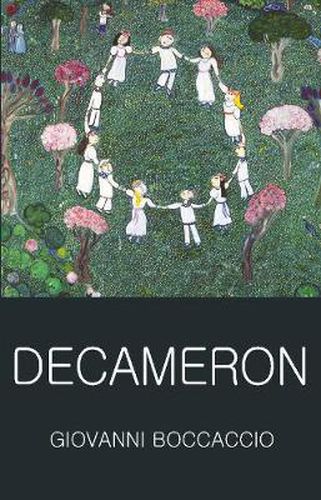Readings Newsletter
Become a Readings Member to make your shopping experience even easier.
Sign in or sign up for free!
You’re not far away from qualifying for FREE standard shipping within Australia
You’ve qualified for FREE standard shipping within Australia
The cart is loading…






A new version of John Payne’s Victorian translation, with an Introduction by Cormac O Cuilleanain 1348. The Black Death is sweeping through Europe. In Florence, plague has carried off one hundred thousand people. In their Tuscan villas, seven young women and three young men tell tales to recreate the world they have lost, weaving a rich tapestry of comedy, tragedy, ribaldry and farce. Boccaccio’s Decameron recasts the storytelling heritage of the ancient and medieval worlds into perennial forms that inspired writers from Chaucer and Shakespeare down to our own day. Boccaccio makes the incredible believable, with detail so sharp we can look straight into the lives of people who lived six hundred years ago. His ‘Decameron’ hovers between the fading glories of an aristocratic past - the Crusades, the Angevins, the courts of France, the legendary East - and the colourful squalor of contemporary life, where wives deceive husbands, friars and monks pursue fleshly ends, and natural instincts fight for satisfaction.
Here are love and jealousy, passion and pride - and a shrewd calculation of profit and loss which heralds the rise of a dynamic merchant class. These stories show us early capitalism during a moment of crisis and revelation. AUTHOR: Giovanni Boccaccio (1313?-1375) is heralded as one of Europe’s foremost storytellers.
Boccaccio moved to Naples with his family in 1326, when his father was appointed to head the Neapolitan branch of his bank. His father secured young Giovanni an apprenticeship at the bank, but it was not a career that appealed to him, and he eventually persuaded his father to let him study law at the Studium in the city. He studied canon law for six years, before leaving to pursue his interests in scientific and literary studies. During his time studying law, Boccaccio was introduced by his father to the Neapolitan nobility, and he quickly fell in love with Maria d'Acquino, a married daughter of King Robert of Naples. Maria was the inspiration for many of Boccaccio’s earlier works. Boccaccio returned to Florence in 1341, having fled Naples due to tensions between the Angevin King and Florence. Boccaccio had not wanted to return to Florence, but continued to work while he was there, producing Comedia delle ninfe fliorentine (also known as Ameto) in 1341, Amorosa visione in 1342 and Fiammetta in 1343. In 1348, Florence was ravaged by the Black Death, which killed 75% of the city’s population. This period of time is represented in one of Boccaccio’s best known works, ‘Decameron’, which Boccaccio began working on in 1349.
$9.00 standard shipping within Australia
FREE standard shipping within Australia for orders over $100.00
Express & International shipping calculated at checkout
A new version of John Payne’s Victorian translation, with an Introduction by Cormac O Cuilleanain 1348. The Black Death is sweeping through Europe. In Florence, plague has carried off one hundred thousand people. In their Tuscan villas, seven young women and three young men tell tales to recreate the world they have lost, weaving a rich tapestry of comedy, tragedy, ribaldry and farce. Boccaccio’s Decameron recasts the storytelling heritage of the ancient and medieval worlds into perennial forms that inspired writers from Chaucer and Shakespeare down to our own day. Boccaccio makes the incredible believable, with detail so sharp we can look straight into the lives of people who lived six hundred years ago. His ‘Decameron’ hovers between the fading glories of an aristocratic past - the Crusades, the Angevins, the courts of France, the legendary East - and the colourful squalor of contemporary life, where wives deceive husbands, friars and monks pursue fleshly ends, and natural instincts fight for satisfaction.
Here are love and jealousy, passion and pride - and a shrewd calculation of profit and loss which heralds the rise of a dynamic merchant class. These stories show us early capitalism during a moment of crisis and revelation. AUTHOR: Giovanni Boccaccio (1313?-1375) is heralded as one of Europe’s foremost storytellers.
Boccaccio moved to Naples with his family in 1326, when his father was appointed to head the Neapolitan branch of his bank. His father secured young Giovanni an apprenticeship at the bank, but it was not a career that appealed to him, and he eventually persuaded his father to let him study law at the Studium in the city. He studied canon law for six years, before leaving to pursue his interests in scientific and literary studies. During his time studying law, Boccaccio was introduced by his father to the Neapolitan nobility, and he quickly fell in love with Maria d'Acquino, a married daughter of King Robert of Naples. Maria was the inspiration for many of Boccaccio’s earlier works. Boccaccio returned to Florence in 1341, having fled Naples due to tensions between the Angevin King and Florence. Boccaccio had not wanted to return to Florence, but continued to work while he was there, producing Comedia delle ninfe fliorentine (also known as Ameto) in 1341, Amorosa visione in 1342 and Fiammetta in 1343. In 1348, Florence was ravaged by the Black Death, which killed 75% of the city’s population. This period of time is represented in one of Boccaccio’s best known works, ‘Decameron’, which Boccaccio began working on in 1349.